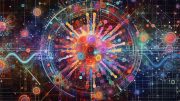
Differences in brain activity between connected and disconnected states of consciousness studied with positron emission tomography (PET) imaging. Activity of the thalamus, anterior (ACC) and posterior cingulate cortices (PCC), and bilateral angular gyri (AG) show the most consistent associations with the state of consciousness (A = general anesthesia, B = sleep). The same brain structures, which are deactivated when the state of consciousness changes to disconnected in general anesthesia or natural sleep (cool colors in the left columns), are reactivated when regaining a connected state upon emergence from anesthesia (warm colors in the right columns). Credit: Scheinin et al., JNeurosci 2020
Activity of brain network linked to changes in connectedness for both sleep and anesthesia.
The loss and return of consciousness is linked to the same network of brain regions for both sleep and anesthesia, according to new research published in JNeurosci.
The biological basis of consciousness has confounded scientists for centuries. Our experimental techniques falter, as the effects of sleep and anesthetic drugs alter brain activity beyond changes in consciousness. In addition, behavior does not always reveal someone’s state of consciousness. An unresponsive person might still be aware of their surroundings (connected), or unaware but still experiencing their internal world (disconnected).
Scheinin et al. sought networks associated with human consciousness by measuring the brain activity of adult males with PET as they fell asleep and went under anesthesia. The research team woke participants mid-experiment to interview them and confirm their state of connectedness.
Changes in connectedness corresponded to the activity of a network comprised of regions deep inside the brain: the thalamus, anterior and posterior cingulate cortex, and angular gyri. These regions exhibited less blood flow when a participant lost connectedness and more blood flow when they regained it.
The pattern held true for both sleep and anesthesia, indicating the changes corresponded to connectedness rather than the effects of sleep or drugs, and that the network may be imperative for human consciousness.
Reference: “Foundations of Human Consciousness: Imaging the Twilight Zone” by Annalotta Scheinin, Oskari Kantonen, Michael Alkire, Jaakko Långsjö, Roosa E Kallionpää, Kaike Kaisti, Linda Radek, Jarkko Johansson, Nils Sandman, Mikko Nyman, Mika Scheinin, Tero Vahlberg, Antti Revonsuo, Katja Valli and Harry Scheinin, 28 December 2020, Journal of Neuroscience.
DOI: 10.1523/JNEUROSCI.0775-20.2020








Be the first to comment on "Imaging the Twilight Zone: The Brain Network Driving Changes in Consciousness"